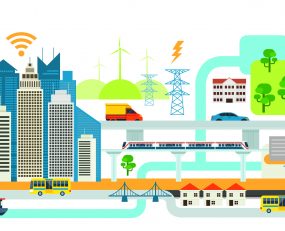
A recent statement by the Intergovernmental Panel on Climate Change (IPCC) (March 2021) has made it clear that efforts to create a carbon neutral economy by the mid-21st Century are ‘not on track’ and that countries which have signed up to climate accords must ‘re-double’ their efforts.
As agreed at the 2015 Paris COP21 meeting, countries publish Nationally Determined Contributions (NDCs) which set out their ambitions and plans to reduce carbon emissions. However, at present, these commitments indicate that by 2030 there will only be a very small reduction in total emissions – less than 1% – compared to the 2010 benchmark.
The IPCC asserted that by 2030 emissions would need to be reduced by 45% compared to 2010 if temperature rises were not to exceed 1.5°C by the end of the century (SR1.5) and net-zero achieved by 2050. To limit global warming to below 2°C (SR2), CO2 emissions would need to decrease by about 25% from the 2010 level by 2030 and reach net zero by around 2070.
Very clearly there will have to be the rapid implementation of ‘green’ policies and a structural change in economic growth if there is to be any chance of reaching these goals, especially difficult given the impact of Covid 19.
The transport and logistics industry will have a major role to play if governments are to meet these net-zero carbon commitments. According to the Smart Freight Centre, transport accounts for 23% of global energy-related CO2 emissions and, of this figure, freight accounts for 42% (i.e. 9% of total emissions). However, the sector has an almost complete dependence on fossil-fuels, a situation which, in the words of Kuehne Logistics University’s Professor Alan McKinnon, is ‘hard-to-abate’. Following the disruption to the world’s economy in 2020 due to Covid, freight CO2 fell by 28% – but this fall is likely to be reversed in 2021 and may even accelerate due to the boom in e-retail last mile deliveries.
If the freight industry is to reduce its carbon intensity to meet corporate and government commitments, it will have to adopt the so-called ‘avoid-shift-improve’ strategy as outlined in Professor McKinnon’s book, ‘Decarbonizing Logistics’:
Unfortunately, in terms of the adoption of alternative fuels in the road freight sector, none of the existing options can rival the all-round utility of diesel. On top of this, comprehensive re-fuelling/re-charging networks do not exist and in any case, many alternative fuels cannot yet be generated by using clean energy. Then there is the problem of adoption throughout the industry. The typical life span of a truck can be 10-15 years, which means that even if the sale of new diesel trucks is banned in, say 2035, many could still be operating in 2050.
The problem for governments is that if they are to meet their targets, the peak in carbon emissions needs to occur sooner rather than later. According to Professor McKinnon, a peak in 2035 means that there would be 28% more accumulated CO2 emissions in the atmosphere than if that peak had occurred in 2025.
So, can the targets be achieved? It is fair to say that governments seem to be ‘betting the house’ on the development of new technologies, especially alternative fuels, and although industry is working at a frenetic pace to bring a range of new green technologies to market, it is still very unclear which will win out. A deadline for phasing out diesel and hybrids may even be counterproductive as manufacturers will inevitably reduce their investment in developing more efficient fossil fuel-based engines.
It seems evident that relying on the ‘shifting’ and ‘improving’ elements of decarbonization to meet the goals will be a considerable stretch and this places more emphasis on ‘avoidance’, requiring action by industry, government and consumers.
These issues affect not only the freight transport industry – all other sectors of the economy are wrestling with the same challenges. To meet the emissions targets, there will need to be significant behavioural change by consumers such as critical mass take up of electric vehicles and move to electric heating. Combining the policies of generating economic growth and employment, whilst reducing carbon emissions will be a considerable – if not impossible – challenge.
Source: Transport Intelligence, March 11, 2021
Author: John Manners-Bell
 John Manners-Bell is CEO of Ti Insight and Founder of the Foundation for Future Supply Chain. Set to be launched in April 2021, the Foundation for Future Supply Chain will provide a major new knowledge resource for governments, non-governmental organisations and business. Its role will be to improve the understanding of some of the most pressing challenges facing the logistics industry and examine their wider implications for societies, the environment and economic development. To find out more about the Foundation, or to contact us, please CLICK HERE.
John Manners-Bell is CEO of Ti Insight and Founder of the Foundation for Future Supply Chain. Set to be launched in April 2021, the Foundation for Future Supply Chain will provide a major new knowledge resource for governments, non-governmental organisations and business. Its role will be to improve the understanding of some of the most pressing challenges facing the logistics industry and examine their wider implications for societies, the environment and economic development. To find out more about the Foundation, or to contact us, please CLICK HERE.